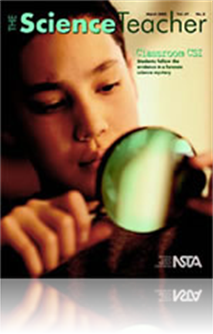All Resources
Journal Article
Discovering Trees: Not Just a Walk in the Park!
An urban classroom participates in a yearlong partnership sponsored by a local botanical garden. Through field trips and classroom activities students observe and learn about seasonal changes in trees and sketch their observations. This partnership s...
Journal Article
An after-school photography club challenges students to find a science topic of interest and create a storyboard through photographs. Community members, parents, and volunteer teenagers help the children develop photography skills as they document th...
Journal Article
The Idea Bank provides tips and techniques for creative teaching, in about 1,000 words. In this month’s Idea Bank learn about an alternative method to paper-and-pencil Punnett Square activities that are often part of an introductory genetics unit....
Journal Article
The author describes how students experience the weeklong summer astronomy camp on a college campus. One favorite student activity is nighttime viewing of the skies, in which students learn to use telescopes to view galaxies, star clusters, and the p...
Journal Article
Science Sampler: Name that Planet!
Wanted: Scientists interested in living in space. These words are the motivation behind this interdisciplinary Earth and space science mini-unit....
Journal Article
The Cycles of Math and Science
Cycles are found throughout nature. In this article, the water cycle is used as an example to help students understand the relationships, patterns, and phenomena that repeat in both math and science....
Journal Article
Teachers are constantly challenged to create a setting where students can engage in comprehensive investigations. Using computer power supplies to power the EC lab demonstrates our commitment to this challenge—to develop a quality investigation tha...
Journal Article
CURRICULUM MAPPING: A How-To Guide—Using curriculum mapping to align instruction
Curriculum mapping focuses on what is actually taught. Teachers see which benchmarks or standards are or aren't being met and which information needs to be added. Ultimately, curriculum mapping should produce a seamless curriculum for a K–12 distr...
Journal Article
Science and Children’s editor shares thoughts regarding the current theme issue of extended elementary sicence learning....
Journal Article
Editor's Corner: Passing On the Passion
The Science Teacher’s editor shares thoughts on the current issue....
Journal Article
Science on the Web: Exploring Hurricane Data
For students to be scientifically literate, it is vital for them to establish connections between science in the classroom and in the world outside. In this guided online investigation, students work in groups to explore the development and progress ...
Journal Article
Can Problem-based Instruction Stimulate Higher Order Thinking?
One of two Instrumental Analysis Laboratory sections at Northern Arizona University was converted from its traditional format into a problem-based format, adding elements of authentic, investigative, and cooperative learning. The project was conceive...
Journal Article
Students learn about the search for extrasolar planets through historical anecdotes and teacher-led demonstrations. Activities include swinging a bucket full of sand around to demonstrate the wobble effect and modeling different solar systems outside...
Journal Article
Who Killed Myra Mains? Students investigate a mock crime scene in an integrated science unit
Students become crime scene investigators as they investigate a mock crime scene in an integrated science unit. In this inquiry-based lab, students must formulate and revise scientific explanations, as well as communicate and defend a scientific argu...
Journal Article
Outstanding Science Trade Books for Students K-12 (Books Published in 2001)
The Outstanding Science Trade Books for Students K–12 is a listing of the best books published in 2001. The selection is made by the National Science Teachers Association/Children’s Book Council Joint Book Review Panel. ...








